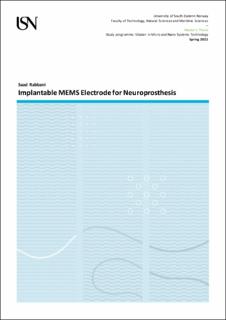Implantable MEMS Electrode for Neuroprosthesis
Master thesis
Permanent lenke
https://hdl.handle.net/11250/2765122Utgivelsesdato
2021Metadata
Vis full innførselSamlinger
Sammendrag
In this thesis, we are microfabricating neural cuff electrodes that will be implanted in the human upper limb and will be utilized for neuroprosthesis. This is a research-based thesis that has been conducted in collaboration with the EEA Grants named “ARMIN”. The goal of this project is to design a neuroprosthesis arm, which can mimic the human upper limb’s motor actions and sensations. The whole prosthesis is the integration of neural implantable electrode including its fabrication, electronics interface, low power wireless communication, a mechanical arm, and its control system. Parts of the mechanical hand will be equipped with artificial skin which will help to receive sensorial feedback. Having many integral parts, this work set its center of attention on the fabrication of MEMS implantable nerve cuff electrodes.
In this thesis, the fabrication of the nerve cuff electrode is described briefly. The task was assigned for the microfabrication of implantable electrodes for neural signals acquisition in the upper limb (arm) neuroprosthesis. For that, three different microfabrication methods are described with the experiments conducted in the cleanroom. For the fabrication material, Pure gold was chosen due to its 100% continuity and conductivity and PDMS was used as substrate material for the electrode. PDMS is used due to its high tensile modulus, physical toughness, elongation, and also it is a good biocompatible material.
After the fabrication of the electrode, laboratory functionality tests were conducted where the electrode was tested with measuring its conductivity, adhesion, rolling test, and biocompatibility test. Different fabrication methods showed different results where the final test showed acceptable results. The adhesion test showed good adhesion between PDMS and gold also conductivity was also measured all over the electrode. Moreover, the biocompatibility test also showed positive results.
